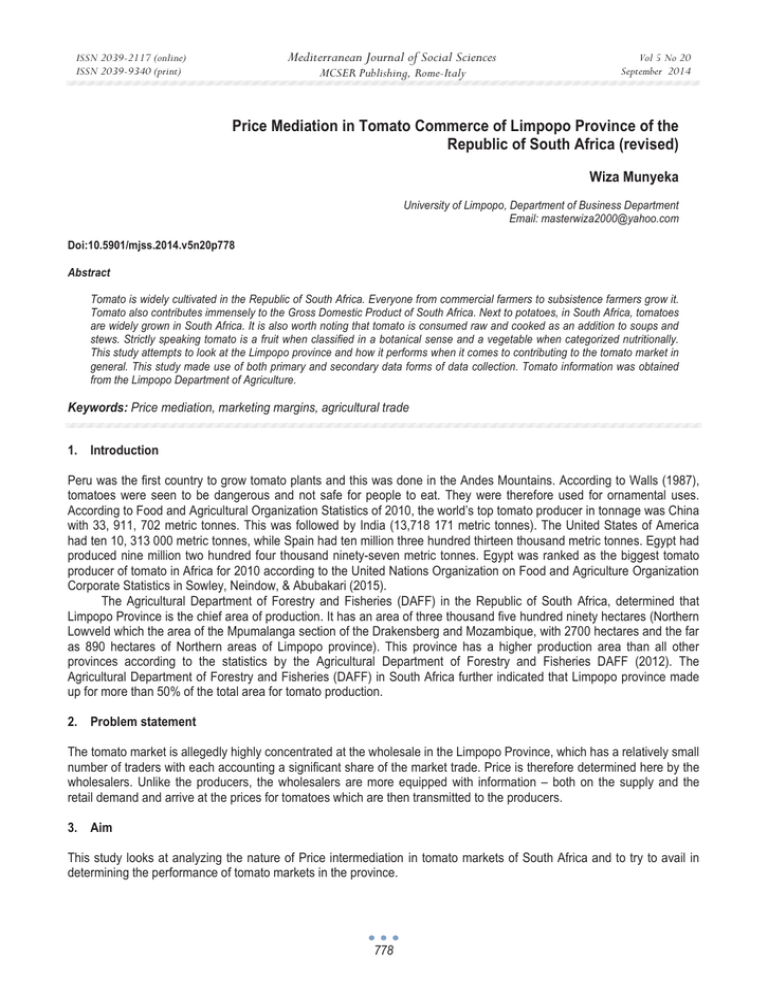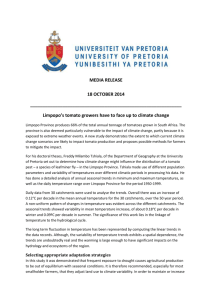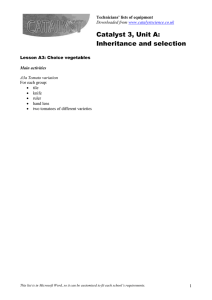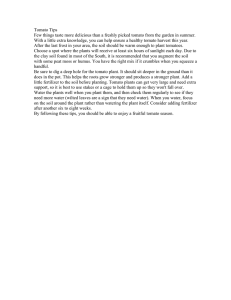Price Mediation in Tomato Commerce of Limpopo Province of the Republic of South Africa (revised)
advertisement

Mediterranean Journal of Social Sciences ISSN 2039-2117 (online) ISSN 2039-9340 (print) MCSER Publishing, Rome-Italy Vol 5 No 20 September 2014 Price Mediation in Tomato Commerce of Limpopo Province of the Republic of South Africa (revised) Wiza Munyeka University of Limpopo, Department of Business Department Email: masterwiza2000@yahoo.com Doi:10.5901/mjss.2014.v5n20p778 Abstract Tomato is widely cultivated in the Republic of South Africa. Everyone from commercial farmers to subsistence farmers grow it. Tomato also contributes immensely to the Gross Domestic Product of South Africa. Next to potatoes, in South Africa, tomatoes are widely grown in South Africa. It is also worth noting that tomato is consumed raw and cooked as an addition to soups and stews. Strictly speaking tomato is a fruit when classified in a botanical sense and a vegetable when categorized nutritionally. This study attempts to look at the Limpopo province and how it performs when it comes to contributing to the tomato market in general. This study made use of both primary and secondary data forms of data collection. Tomato information was obtained from the Limpopo Department of Agriculture. Keywords: Price mediation, marketing margins, agricultural trade 1. Introduction Peru was the first country to grow tomato plants and this was done in the Andes Mountains. According to Walls (1987), tomatoes were seen to be dangerous and not safe for people to eat. They were therefore used for ornamental uses. According to Food and Agricultural Organization Statistics of 2010, the world’s top tomato producer in tonnage was China with 33, 911, 702 metric tonnes. This was followed by India (13,718 171 metric tonnes). The United States of America had ten 10, 313 000 metric tonnes, while Spain had ten million three hundred thirteen thousand metric tonnes. Egypt had produced nine million two hundred four thousand ninety-seven metric tonnes. Egypt was ranked as the biggest tomato producer of tomato in Africa for 2010 according to the United Nations Organization on Food and Agriculture Organization Corporate Statistics in Sowley, Neindow, & Abubakari (2015). The Agricultural Department of Forestry and Fisheries (DAFF) in the Republic of South Africa, determined that Limpopo Province is the chief area of production. It has an area of three thousand five hundred ninety hectares (Northern Lowveld which the area of the Mpumalanga section of the Drakensberg and Mozambique, with 2700 hectares and the far as 890 hectares of Northern areas of Limpopo province). This province has a higher production area than all other provinces according to the statistics by the Agricultural Department of Forestry and Fisheries DAFF (2012). The Agricultural Department of Forestry and Fisheries (DAFF) in South Africa further indicated that Limpopo province made up for more than 50% of the total area for tomato production. 2. Problem statement The tomato market is allegedly highly concentrated at the wholesale in the Limpopo Province, which has a relatively small number of traders with each accounting a significant share of the market trade. Price is therefore determined here by the wholesalers. Unlike the producers, the wholesalers are more equipped with information – both on the supply and the retail demand and arrive at the prices for tomatoes which are then transmitted to the producers. 3. Aim This study looks at analyzing the nature of Price intermediation in tomato markets of South Africa and to try to avail in determining the performance of tomato markets in the province. 778 ISSN 2039-2117 (online) ISSN 2039-9340 (print) 3.1 Mediterranean Journal of Social Sciences MCSER Publishing, Rome-Italy Vol 5 No 20 September 2014 Objectives of the study The objectives of the study are to: i. Give an overview of tomato production and marketing in South African. ii. To provide a Share analysis of provincial shares towards national tomato exports. 4. Literature Review: The Tomato Industry in General This study relied on the United Nations Organization on Food and Agriculture Organization Corporate Statistics (FAOSTAT) was one of the supporting bases. The measurements on worldwide and national tomato generation insights were gotten from that source. The South African Agricultural Department of Forestry and Fisheries and Statistics of South Africa were alternate wellsprings of production insights. The town of Tzaneen in the Limpopo Province was perfect as it has open field tomato production activities. Secondary data and a survey of the commonplace level exchange information shows a fascinating perception of the tomato production. This is however, to some degree a deceiving perspective picture of the tomatoes bound for fare markets. Case in point is the way that R10 373 148 worth of the produce was traded in 2012 and deemed as coming from the Gauteng territory. This does not infer that the tomatoes were grown there but rather that the enlisted exporters were situated in Gauteng. Furthermore territories like Kwa-Zulu Natal and Western Cape fill in as leave focuses for tomato through Durban and the city of Cape Town harbors individually. A survey of the information sharing common level shows a fascinating though to some extent deceiving the prospect of wells tomatoes intended for rates markets. First, the way in which R10 373 148 tomatoes sold in 2012 was Gauteng territory does not mean that tomatoes were delivered there, but instead enrolled exporters were located in Gauteng. Furthermore territories as Kwa-Zulu Natal and Western Cape is filled like leaving approaches tomato through ports of Durban and Cape Town individually. A closer Look at the tomato distributes in Figure 1 reveals the following things. It is seen that the three regions of the Western Cape, Kwa-Zulu Natal and Gauteng were reliably the highest tomato trading regions of the Republic of South Africa in the course of the most recent decade. In 2010, Limpopo and Mpumalanga enrolled extensive fare values. Different areas highlighted irregularly, however typically enrolled zero exchange. In 2011, the Limpopo and Mpumalanga provinces recorded no trade in tomatoes. The Free State, North West, Mpumalanga and Limpopo provinces in 2012 recorded considerable tomato export values. High export value for Mpumalanga and Limpopo can be credited to high export to bordering countries (Mozambique and Zimbabwe). In the same year the export value for Western Cape, Kwa-Zulu Natal and Gauteng have dropped significantly. 4.1 Value of tomato exports by South Africa Used with the permission from the South African Agricultural Department of Forestry and Fisheries (DAFF) Figure 1: Highlights of the tomato exports 779 ISSN 2039-2117 (online) ISSN 2039-9340 (print) 4.2 Mediterranean Journal of Social Sciences MCSER Publishing, Rome-Italy Vol 5 No 20 September 2014 Share analysis of the Republic of South Africa Table 2 is a representation of common shares towards national tomato trades. It demonstrates that province of the Western Cape together with the provinces of Gauteng and province of Kwa-Zulu Natal territories have summoned the best share of tomato fares for as long as ten years. This is notwithstanding the way that provinces of Limpopo, Mpumalanga and the Eastern Cape areas are the main makers of tomatoes. As clarified before, this implies the main fare territories (Western Cape, Gauteng and Kwa-Zulu Natal provinces) get their leeway from the way that the enrolled exporters are situated in their areas and they likewise have leave focuses for tomato trades. The above situation raises worries about the accessibility of showcasing framework and agro-coordinations in the significant tomato delivering territories of South Africa. In 2011, Western Cape Province ordered 60.20% and Gauteng province summoned 38.37% of the aggregate South African tomato sends out. Amid 2012, Western Cape Province send out share dropped to 21.75% and in the meantime, Gauteng province trade share has expanded to 45.55%. Free State summoned 9.01% fare share following eight years of recording zero exchange. North West likewise directed a 1% share of tomato fares without precedent for a ten-year time frame. Table 1: Used with the permission from the South African Agricultural Department of Forestry and Fisheries (DAFF) 4.3 Share analysis of the Limpopo Province According to Table 2, it shows that in 2009 that the district of Vhembe controlled all of all tomato distributes in the Limpopo Province. The periods from 2003 to 2008, records state that there were no tomato exports from Limpopo province. The following year in 2010, district of Capricorn led with the greatest share of tomato exports from Limpopo province. Zero trade in tomatoes during 2011 were Limpopo province. In 2012, Waterberg district emerged as the leading province with a share of 86.61% of tomato export from Limpopo Province. Table 2: Used with the permission from the South African Agricultural Department of Forestry and Fisheries (DAFF) 780 ISSN 2039-2117 (online) ISSN 2039-9340 (print) 4.4 Mediterranean Journal of Social Sciences MCSER Publishing, Rome-Italy Vol 5 No 20 September 2014 Prices of tomato exports from the Limpopo province Used with the permission from the South African Agricultural Department of Forestry and Fisheries (DAFF) According to figure 2 above, Limpopo province tomato exports were recorded from the year2009 and to the year 2010. The years 2003, 2008 and 2011, the province of Limpopo recorded a zero trade. However, in the year 2010, Capricorn district recorded a substantial export price for the Limpopo province in the Republic of South Africa, re-establishing the province as the leading tomato grower. In spite of the fact that the Limpopo province is one of the highest growers of tomatoes, during 2011, Limpopo recorded zero trade in tomatoes. In 2012, Vhembe and Waterberg recorded considerable export values. This was a progressive development as Limpopo province is one a leading producer of tomatoes. 4.5 Tomato production Approximately over 600 producers in both the large scale and small scale sectors exist in the Republic of South Africa according to Mogala (2013:4). Mogala (2013:4) furthermore goes on to say that the large scale sector makes up 95% of the total produce. While the remaining 5% is what the small scale sector makes up. Mogala (2013:4) furthermore states that during 2004, production output increased by 5.5% when compared to 2003 production output. In 2005, production output dropped by 4.5% and during 2007, the output dropped further by 5.1%. From 2008 to 2010, there was a steady increase in production output until 2011. The production output dropped by 6.7% during 2011 when equated to the preceding year of 2010. The maximum production output was noted in 2012, and the increase was pegged at 9% from the 2011 figures (see Figure 2 below). Tomato production was stable above 40 000 tons per annum over the past decade. The drip in numbers of produce in the years of 2006, 2007 and 2011 can be attributed to negative environmental settings and great production expenses. The rankings from highest producer to lowest according to FAOSTAT, is as follows: China, followed by India, United States, Turkey and lastly, Egypt. 63% of the world’s tomato production is represented by these countries. In the world, Egypt is the only African country amongst top ten world tomato producers. United Kingdom (UK), Netherlands, Belgium and Sweden are the top tomato producing countries with the highest yields per hectare globally. Used with the permission from United Nations Organization on Food and Agriculture Organization Corporate Statistics (FAOSTAT) Figure 2: the 9% increase 781 ISSN 2039-2117 (online) ISSN 2039-9340 (print) Mediterranean Journal of Social Sciences MCSER Publishing, Rome-Italy Vol 5 No 20 September 2014 5. Research Methodology This study utilized Heien's (1980) markup pricing model to examine the price transmission behavior between market levels. This model assumes that the market is competitive, fixed - proportion production technology and constant returns to scale in food marketing system. The pricing rules are in the following general form: R = bIW + b2Z F=atWI+a2Z In the above, R is retail value, W being the wholesale value, F is farm value and Z is a value vector (supposed exogenous) of selling inputs, a], a2, b) and b2 are the coefficients of the Variables. The causality test developed by Granger (1977) provides us the nature of the causal direction and lead/lag relationship between prices. Granger detailed a definition of causality amid a set of variables that is grounded on predictability the aspect that there is a time factor that affects the exogenous variable on an endogenous variable. According to Granger, a given universe or information set that includes X and Y, a variable X causes another variable Y. And if this can best be projected using the last X value that no, all others in the universe past information that is used in each case. The causality between Y and X is defined in the same way. Feedback happens if X results in Y and if Y results in X. A fundamental link between X and Y will not happen if there is no connection between X and Y or vice versa. A variety of testing procedures have evolved in applying the Granger definition to economic time series. For the purpose of this study, direct Granger Test (1969) and Haugh (1972) and Pierce (1977) were employed. 5.1 Direct Granger Test Direct Granger test as defined by Geweke (1980) depends on direct ordinary least square reversions on levels of the time sequences records. On occasion it is recommended that the records collection be converted before causality tests are carried out. Prefiltering approaches taken into consideration consist of first and second differencing and second order clear out of the shape (1 - 0.seventy five l) 2 as counseled by Sims (1972). 6. Research Design and Data Collection Methods As earlier alluded to, this study made use of both primary and secondary data. One of the Tomato information sources was the Limpopo Department of Agriculture. The United Nations Organization on Food and Agriculture Organization Corporate Statistics (FAOSTAT) was another source. The continuity and availability of data for all levels of selected items, size of the market centres and consumers was the criteria used for the selection of the sample period, market centres and types of tomato centres. 7. Research Findings The results of the Granger causality test performed on the tomato produce selected are summarized in Table 1. 7.1 Marketing Margins Table 1: F Value Regression b instantaneous One way Direction of Causality d Tomato WS:FM 48.73* 22.13* WS +- FM Tomato FM :WS 37.15* 0.16 Tomato WS :RT 43.71* 1.55 Tomato RT: WS 119.1* 7.99* RT +- WS Note: a. Lag length determined through Akaike's information criterion b. The variable to the left of column is dependent: FM, WS and RT refer to farm wholesale and retail prices respectively c. Test is based on equation (3) and (I) d. Test is based on equations (2) and (I) - Asterisk represents rejection of null hypothesis of no causality significance level ex = 0.0 I CO), ex = 0.05 C**) 782 ISSN 2039-2117 (online) ISSN 2039-9340 (print) Mediterranean Journal of Social Sciences MCSER Publishing, Rome-Italy Vol 5 No 20 September 2014 Wholesale prices were found to lead farm price in Limpopo Province. The lagged changes in wholesale prices were expressively stationed at the 70% assurance level with the present difference in farm prices. In other words, the variations in the wholesale prices tend to lead variations in the farm worth of the above. The fact that the Limpopo province produces a lot of tomato should make it mediate the price. In the Limpopo province, the price is considerably mediated but once the produce goes to the Gauteng or Cape Town markets, those marketers then mediate the prices according. For example, transportation costs come into play. Apart from assessing the effect of tomato commerce on price mediation, granger test applied in tomato markets of the Limpopo Province may also provide a rough indication of transfer costs. 8. Discussion, Conclusions and Recommendations Mogala (2013) rightly puts it as, in South Africa, tomato dealers are found in both the prescribed and casual sectors. In the prescribed sector, this includes formally registered retail chains, supermarkets and neighborhood stores. Mogala (2013) adds on to say that the casual sector covers tuck shops (sphaza) or what are known as small stores, and vendors. In this environment, tomato sales are at fixed prices. The prices are generally determined separately or in lesser bundles. The Limpopo Tomato Growers Association (LTGA) of the province of Limpopo is a result of the tomato farmers with the aid of the Agricultural Provincial office making the farmers more organized. The Limpopo Tomato Growers Association (LTGA) exists as an association that caters for tomato industry. It is committed to changing small scale farmers to commercial producers. The aim is to make wealth, employment and ownership of the tomato industry. The organization also makes sure the members grow by offering and facilitating training, mentorship progammes, access to financial services as well as market and entrepreneurial exposure of the members. The Gauteng Province is were bulk of the tomatoes are registered in South Africa. In this regard, literature identifies the Gauteng Province as were the tomatoes were coming from. This is because most of the registered traders are in Gauteng Province and not that Gauteng grows the tomatoes. The outcome of the tests indicates that the price mediation at the farm retail and wholesale levels cannot be rejected for all tomato under study. One important recommendation includes the study of price mediation from retail to farm level in the South African context. The study of the role of institutions like the Limpopo Tomato Growers Association (LTGA) and the government policy interventions of price spreads, and study of international comparisons of marketing margins. Retail-to-farm price mediation studies are not only important for the sake of understanding the price mediation process better. They are important from the standpoint of estimating the effects of retail demand changes like commodity advertising on tomato farm prices. In conclusion, in order to understand the tomato market in South Africa, it is recommended that further research is need to investigate the price mediation in the tomato pricing sector. The competitive market structures in the tomato sector which might provide a deeper understanding of the differences in price mediation in the tomato pricing also need to be looked at in future research. References Askew, D.J. (1996). Tomato production guideline for the Umlaas river valley area of Kwa-Zulu - Natal: Department of Horticultural Science, University of Natal: ISBN 1- 86840-203-7. DAFF, (Department of Agriculture, Fisheries and Forestry). (2012). A profile of South African tomato market value chain. www.daff.gov/docs/amcp/tomatomvcp (2010) pdf accessed in May 2012. FAOSTATS, http//en.wikipedia.org/wiki/tomato accessed in July 2013. Granger, C.W. (1977). Investigating causal relationship by econometric models and Cross spectral Method. Econometrica 37: 424-438. Geweke, J.B. (1980). Inference and causality in economic time series. MICHAEL INTRILLIGATOR (ed.) Zvi Grilichis and Handbook of Econometrics 17. Amsterdam: North: HoIland Publishing Company. Haugh, L.D. (1976). Checking the independence of two covariance stationary time series: A univariate the residual cross-correlation approach. Journal of the American Statistical Association. 71(6): 378-385. Heien, D.M. (1980). "Markup pricing in a dynamic model of the food industry", American Journal of Agricultural Economics 62:1018. Mogala, M. (2013). A profile of the South African Tomato Market Value Chain. Department of Agriculture, Forestry and Fisheries. Republic of South Africa Pierce, D.A. (1977). Relationship and the lack Thereof - between economic time series, with special Reference to money and interest rates. Journal of the American Statistical Association 72: 11-22. Sowley, E. N., Neindow, M., & Abubakari, A. H. (2015, February 28). Effect of poultry manure and NPK on yield and storability of orange- 783 ISSN 2039-2117 (online) ISSN 2039-9340 (print) Mediterranean Journal of Social Sciences MCSER Publishing, Rome-Italy Vol 5 No 20 September 2014 and white-fleshed sweet potato [Ipomoea batatas (L.) Lam]. Retrieved March 24, 2017, http://www.academicjournals.org/journal/ISABB-JFAS/article-references/4EBEC8D50286 Walls, I.G. (1987). Concorde gardening: simple growing tomatoes, 2nd ed. Ward Lock Limited, London: ISBN 0-7063-6505-4. 784 from



